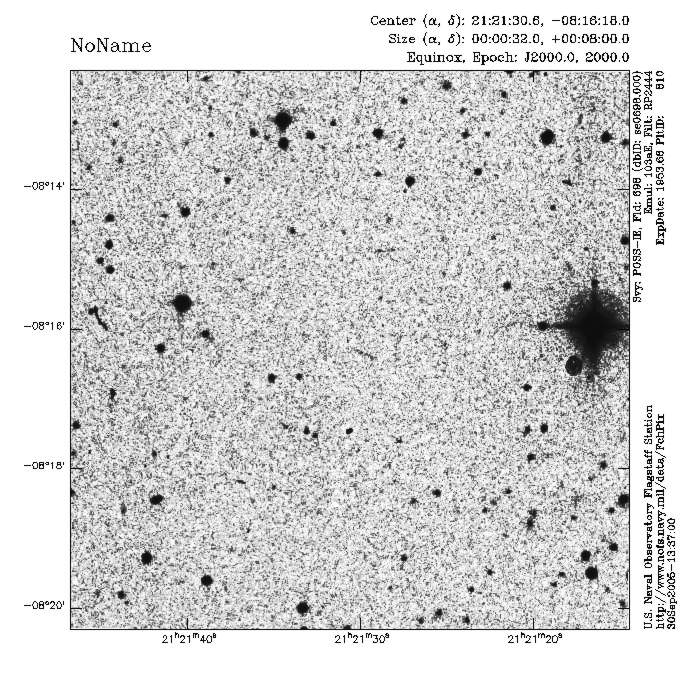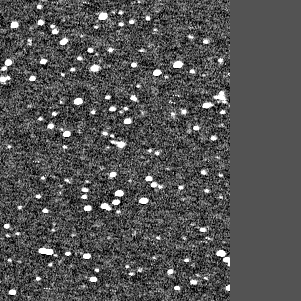

Here are the discovery images of the asteroid "Caripito", taken on the evening of Sunday, August 3, 2003 from the George Observatory, a Houston Museum of Natural Science satellite facility located inside Brazos Bend State Park, a Texas state park near Houston. I have aligned the stacks and then cropped out an area centered on the object, padding as necessary. The object starts out just to the left of a star, then is merged with the star, then pops out to the right of the star. The 6 images span about 80 minutes.
The night before, Bill Dillon (leader of the Fort Bend Astronomy Club asteroid discovery team) and I had been running the 18" East-dome telescope at the George observatory in visual mode, showing various things in the sky (but mostly Mars, Mars, and yet more Mars) to the public. The observatory is open to the public almost every Saturday night. In August 2003 the crowds were unusually heavy, because Mars was putting on its best show in thousands of years.
Canadian amateur astronomer Andrew Lowe had asked us to shoot one of his asteroids, which he had recently discovered while mining online sky-survey archives on the internet. Andrew discovers asteroids in the past, by looking for unexplained streaks on sky-survey images. He then predicts where they should be now, and if they are within reach of our telescope, we try to image them in the present for him! So after the last of the public left for the night, we mounted our CCD camera onto the telescope and pointed it towards the predicted position of 1991 TP16 (now asteroid 65698 Emmarochelle). Would it actually be where it was expected to be, 12 years later? (It was, nearly exactly. Physics really works!)
I went out the next night to shoot the field again, because we received a "special request" by e-mail from the minor planet center after we had turned in Saturday night's data. For an amateur astronomer to be requested to make an observation on their behalf is a high honor, and we snapped to attention!
Could you possibly target your F3803G for a second night? We believe this is 2002 CZ231, but if so there is a problem with the existing observations and we would like to identify the problem.
Alas, the weather did not really cooperate, and I failed in my attempt to get another observation on the requested object that night (I succeeded a few nights later, though). Here is my report from the night:
Last night was a marginal night... sometimes clear, but most of the time hazy due to high cirrus, with bands of fast-moving thick low clouds moving through every 30 minutes or so.
Had some refugee spouses from the astronomy class going on in the big dome get bored and wander over and watch what I was doing for about an hour. They asked lots of questions.
Data processing will be a real pain because of all the cloudy intervals I'll have to watch out for. On the plus side, seeing was really good.
Lots of mosquitoes!
While carrying the trash downstairs I thought I saw something sweep right past my face... and there it was again. And again. Turned on my white light and it was a BAT flying by extremely close to my face repeatedly.
I must have built up some good karma with all my service to Andrew, the Saturday-night Mars-mad park visitors, the bored Sunday-night astronomy-class spouses, and the minor planet center. There was a bright unknown asteroid near the right edge of the field, bright enough that I got it easily despite the marginal weather conditions. Usually objects that bright turn out to be known (but off course) objects, and you don't get to keep discovery credit on them for long. This was one of the rare exceptions.
I got credit as solo discoverer of the object, and after we followed it for a while, we had nailed down the orbit well enough that Andrew was able to do us the favor of finding images of the object in the online sky-survey catalogs. In fact, he found an image all the way back in 1953! Wow! That nailed down the orbit well enough that the object became eligible for naming. (Usually you have to keep following the object for years before that happens.)
Here is the image from 6 Sept 1953, a 45-minute exposure onto film. Over that time the asteroid noticeably moved; it's the not-quite-horizontal streak dipping to the right in the middle of the image. (There is another asteroid streak, a nearly horizontal one from an already known object, a ways above it and a tiny bit to the right. As for the other "streaks" you may perceive... who really knows, but probably those are just random alignments of noise tickling your brain.)
I had been wanting to honor my parents with an asteroid somehow. I wanted it to be one for which I was the only discoverer. I had a few possibilities among those. Which one to use? And what, exactly, to name it? The international committee of astronomers who have to approve all asteroid names prefer interesting names. Trying to name an asteroid for yourself is not allowed. And "but I was naming it after my parents, really, honest, not myself!" doesn't cut any ice, either. So "Dellinger" was out. Besides, I wanted something more subtle, unique, and personal than that.
I had only once before had a solo discovery link back to an observation in the 1950's. Aha! I would name this asteroid after the city in Venezuela where my parents met, Caripito. The streak image above was recorded while my parents were living in Venezuela, in the anniversary month of their marriage.
After an interruption due to World War II, my father was able to attend college. Upon graduation in 1948, he accepted a job working for Creole petroleum in Caripito, Monagas, Venezuela. Many of the workers lived in an oil camp town there. There he became fluent in Spanish, and became friends with my mother's oldest brother, Tello, who also worked there. (My mother's family are Mexican-Americans from Brownsville, Texas, at the Southernmost tip of the central United States.) In 1949, after my mother graduated from college, she took a vacation to visit her brother, met my father at the oil camp town in Caripito, and six weeks later they were married!
They lived in Venezuela for the next decade, moving about from one Venezuelan oil camp town to another, for two of those years living deep in the jungle in very primitive circumstances. More than 50 years later they are still happily married and still discuss their time in Venezuela often, and the whirlwind romance in the town of Caripito that brought them together. I grew up hearing their stories. Of course, what had been a little town 50 years ago is now a substantial modern city.
Caripito 78816 Caripito, Bolivar district, Monagas, Venezuela
(78816) Caripito = 2003 PZ9
Discovered 2003 Aug. 4 by J. Dellinger at Needville.
Caripito, Bolivar district, Monagas, Venezuela, is a town on the San Juan
river near the Gulf of Paria. In the 1930-60s it served as a camp town for
the Quiriquire oil field. The parents of the discoverer, Thomas Baynes
Dellinger (b. 1926) and María de la Garza Cantú (b. 1928), met there in
1949.
Here is an orbital animation of Caripito the asteroid, courtesy of JPL.